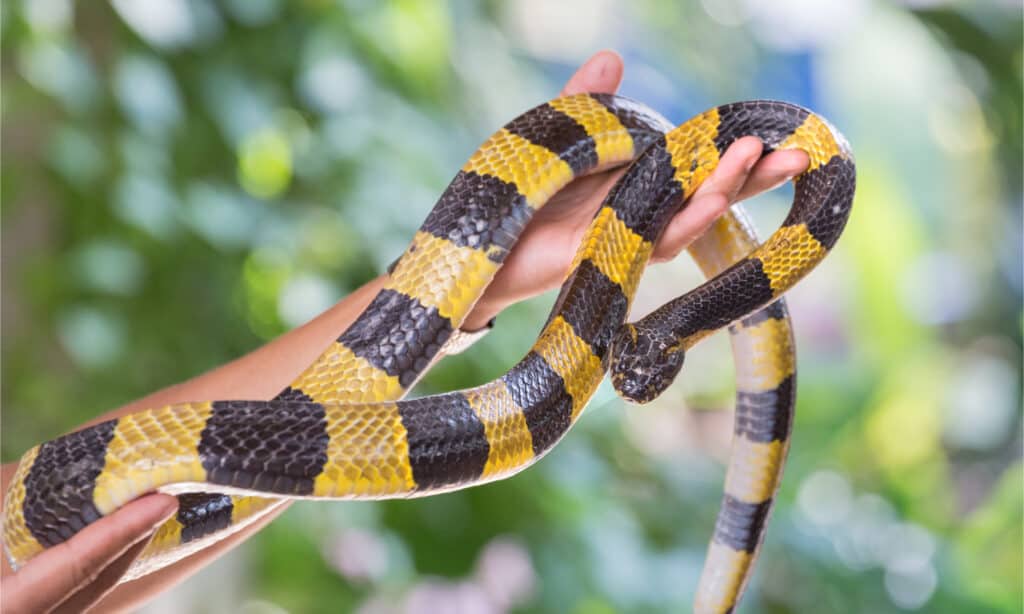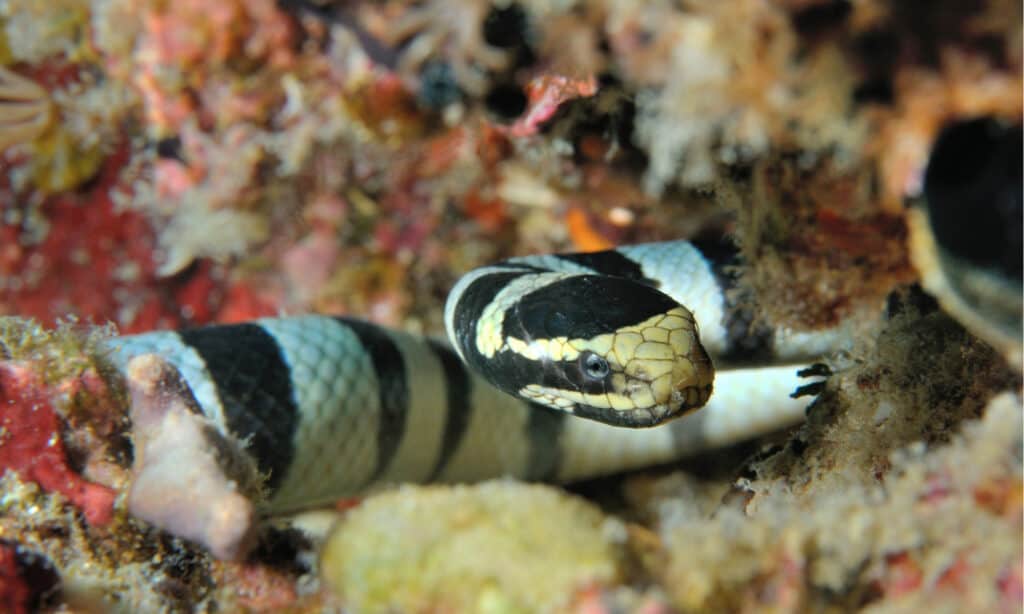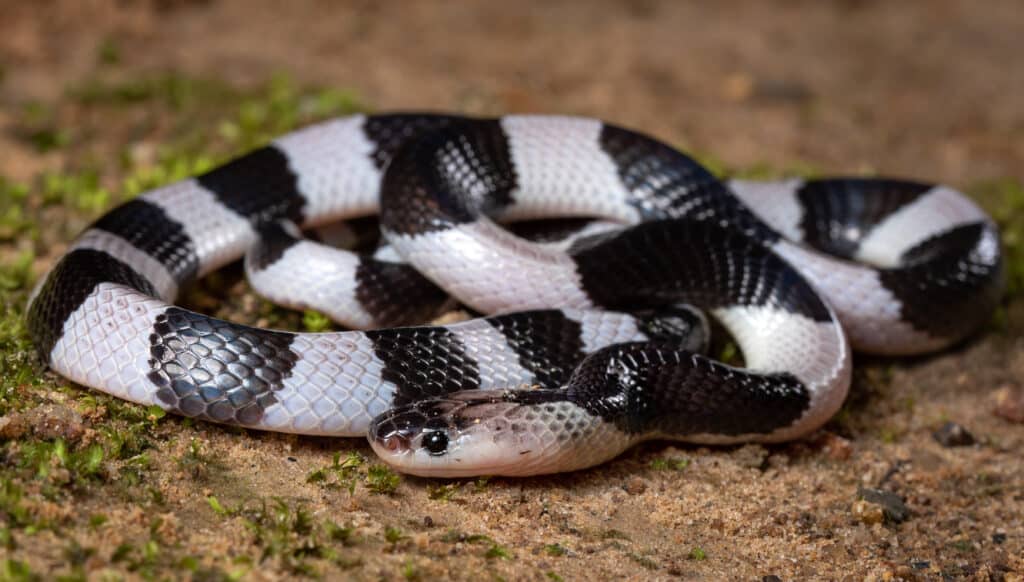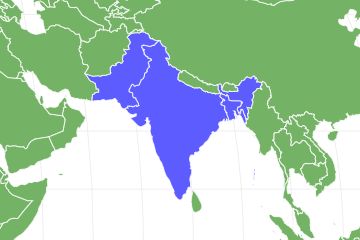Krait
A painless bite that can result in death.
Advertisement
Krait Scientific Classification
Read our Complete Guide to Classification of Animals.
Krait Conservation Status
Krait Facts
- Prey
- Other snakes, lizards, rodents, fish
- Fun Fact
- A painless bite that can result in death.
- Diet for this Fish
- Carnivore

A painless bite that can result in death.
Unlike the bite from many venomous snakes, the bite from a krait is relatively painless. That doesn’t mean it isn’t doing damage. The highly dangerous snake will inject venom that results in paralysis over a period of hours. Without prompt medical treatment, death by suffocation is a common result.
There are 16 species of kraits, including the banded, Indian, Malayan, and Burmese. The Indian, or common, krait is endemic to India and the surrounding region.
Yellow-lipped and other sea kraits are not in the same genus as the land-dwelling kraits. When on land, the yellow-lipped and other sea kraits are extremely docile, to the point where children often play with them. They are less docile in the water, although they still prefer to avoid confrontation whenever possible.
The pronunciation of krait uses a long I sound and rhymes with kite.
Krait Amazing Facts

©jeep2499/Shutterstock.com
- The common krait is one of the Big Four Snakes, responsible for the majority of medically significant cases of snake bites in humans in the Indian subcontinent. The other three are the Indian cobra, Russell’s viper, and Indian saw-scaled viper.
- The initial bite of the common krait is often painless.
- Of all the snakebite deaths in Bangladesh, over 50 percent are from the common krait.
- Humans often encounter kraits during the rainy season, when they enter homes to find dry ground.
Where to Find Them
Kraits are found on the Indian subcontinent. They make their homes in both farmlands and forests.
Evolution and Origins
Kraits can be found across tropical Asia, spanning from regions close to Iran, throughout the Indian subcontinent (including Sri Lanka and Bangladesh), and extending to Southeast Asia (including Indonesia and Borneo).
While banded sea kraits primarily reside on land, they possess remarkable adaptations for hunting in coral reef environments, such as their ability to hold their breath for extended periods and a paddle-shaped tail that enhances their swimming capabilities.
The Bengal krait, scientifically known as Bungarus caeruleus, is a venomous elapid snake species belonging to the Bungarus genus.
It is native to the Indian subcontinent and is recognized as one of the “Big Four” snake species responsible for the majority of snakebite incidents in Pakistan, India, and Bangladesh.
Scientific Name
The scientific name for the common krait is Bungarus caeruleus. It is one of 16 species in the Bungarus genus. The pronunciation is krite. Sea kraits are not close relatives, belonging to the genus Laticauda.
Here are the different types:
- Banded krait (Bungarus fasciatus)
- Common krait (Bungarus caeruleus)
- Blue krait (Bungarus candidus)
- Many-banded krait (Bungarus multicinctus)
- Northeastern Hill Krait (Bungarus bungaroides)
- Montane Ceylon Krait (Bungarus ceylonicus)
- Red-headed krait (Bungarus flaviceps)
- Suzhen’s krait (Bungarus suzhenae)
- Persian krait (Bungarus persicus)
- Sind krait (Bungarus sindanus)
- Greater black krait (Bungarus niger)
- Red River krait (Bungarus slowinskii)
- Lesser black krait (Bungarus lividus)
- Burmese krait (Bungarus magnimaculatus)
- South Andaman Krait (Bungarus andamanensis)
Population and Conservation Status

©Oksana Golubeva/Shutterstock.com
The common krait is endemic to the Indian subcontinent. Its numbers have not been researched and its status has not been evaluated by IUCN. Of the other species of kraits, the Red River krait is considered vulnerable.
How to Identify Them: Appearance and Description
The common krait can be identified by its glossy black body with white bands. Young snakes have wider bands, while the bands on mature kraits are narrow. Their underside is white. The head is slightly wider than the neck, and they have small dark eyes and a rounded snout.
Venom: How Dangerous are They?

©Nenad Preradovic/Shutterstock.com
Krait venom is incredibly damaging to the body. More potent than cobra venom, krait venom can lead to death within 8 hours. The actual bite from a krait isn’t necessarily painful and often leaves minimal if any, swelling. This can lead to complications if the individual who is bitten doesn’t realize the importance of seeking immediate medical care.
Behavior and Humans
Kraits are not generally aggressive, particularly during the day. However, they are nocturnal meaning they are much more active at night. Approaching or cornering one at this time increases the likelihood of a bite.
Similar Animals
View all 77 animals that start with KKrait FAQs (Frequently Asked Questions)
How poisonous is a krait?
Kraits are incredibly venomous. In fact, the common krait is responsible for many of the serious snake bites that occur in India and the surrounding areas of Southern Asia.
The venom is a neurotoxin, which causes muscle paralysis. The bite itself is often not painful, but immediate medical attention is important. Untreated, death typically occurs within 8 hours of the bite.
What is the difference between a snake and a krait?
Kraits are a species of snakes.
What happens when a common krait bites?
Venom from the common, or Indian, krait leads to muscular paralysis. Initially, an individual who is bitten may experience stomach pain. As symptoms progress, the individual may develop tension in the face and difficulty breathing. Death from the bite of a common krait is typically the result of suffocation, due to paralysis of the respiratory system.
Are kraits poisonous?
Yes
What are the types of kraits?
Indian, Malayan (or blue), northeastern hill, South Andaman, Sri Lankan, red-headed, banded, lesser black, Burmese, black, many-banded, Iranian, Red River, Sind, and Suzhen’s.
The sea kraits, such as the yellow lipped krait, are in a different genus than land kraits. While they are also venomous, they are very docile, particularly when on land, and bites are rare.
Is a krait the same as a cobra?
No. Both kraits and cobras are members of the same family, Elapidae, but are different species. The Elapidae family also includes mambas and adders.
How Do You Pronounce Krait?
The pronunciation of krait is krite, with a long “i” sound.
Thank you for reading! Have some feedback for us? Contact the AZ Animals editorial team.
Sources
- Science Direct, Available here: https://www.sciencedirect.com/topics/pharmacology-toxicology-and-pharmaceutical-science/common-krait
- Toxicology, Available here: http://toxicology.ucsd.edu/Snakebite%20Protocols/Bungarus.htm
- American Oceans, Available here: https://www.americanoceans.org/species/banded-sea-krait/
- iNaturalist, Available here: https://www.inaturalist.org/guide_taxa/1330037

















